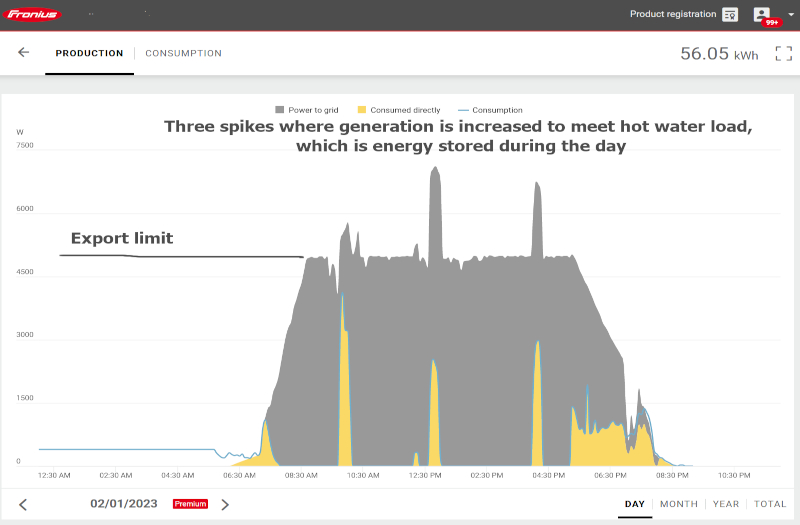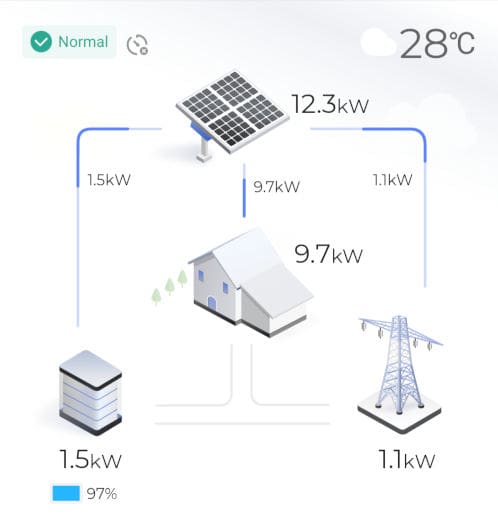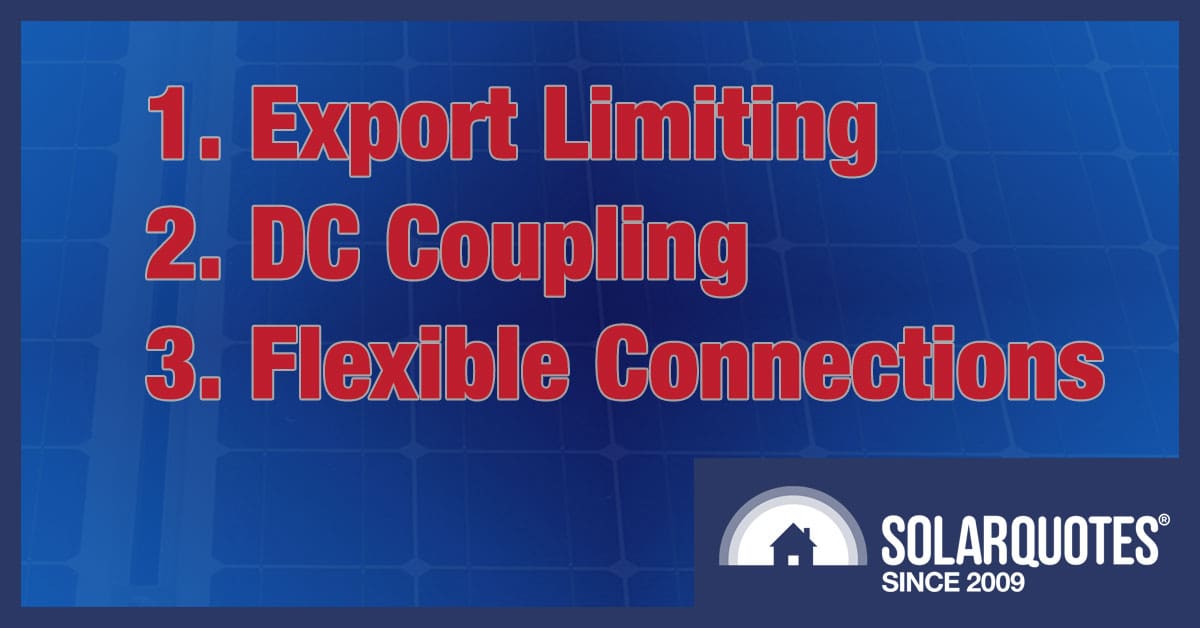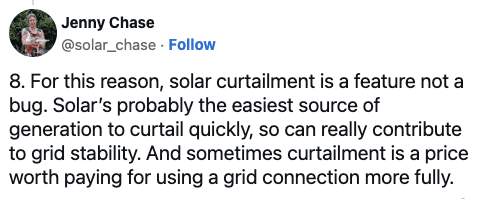As we enter 2024, Australia’s solar capacity is so high that curtailment is sometimes necessary.
If you own a rooftop solar system that experiences curtailment, that might not sound like good news. However, it’s important to think of the bigger picture. As long-time solar analyst Jenny Chase suggests, we should shift our mindset from energy scarcity to energy abundance.
Solar curtailment is a feature, not a bug, so we need to learn not to worry when solar energy is curtailed. If we want enough solar energy to sustain us through overcast days, early mornings, late afternoons, and winters, then part of the design includes curtailing it for a few hours on good solar days1.
To understand how to properly size and utilise rooftop solar in 2024, you must have a good grasp of three essential terms. This knowledge is vital, because for those raised to conserve every kilowatt-hour of energy (due to the fact that every kWh required fuel), the specifics can be quite counterintuitive.
Solar Term #1 Export Limiting
Understanding how Export Limiting works dynamically is crucial to maximising the benefits of your solar energy system and obtaining genuinely free solar energy2.
Understanding Export Limits:
Think of the export limit as a threshold – it’s the maximum energy your solar system can send to the grid at any given moment. Generally set at 5kW (around 22 amps), this limit is imposed by your DNSP (the poles and wires people) because it’s important for maintaining grid stability.
How does it affect your solar experience? Firstly it means that most stack-em-high, sell-em-cheap systems are now sold with a 5kW inverter. If you have a 5kW inverter, you don’t need export limiting because the inverter on the wall becomes the export limit by default.
If your inverter is larger than the export limit, the good news is you will automatically get a little smart meter installed with your solar panels.
@solar_quotes Don’t buy #solar without one of these!
As well as providing proper consumption monitoring via your solar inverter’s app, this little meter enables that 8 or 10kW inverter to throttle it’s output to the grid for export limiting, while still maintaining enough solar output to satisfy your needs at home.
Export Limiting In Action
Imagine this simplified scenario: your home is using no energy, your export limited system (8 kW inverter export limited to 5 kW) system is generating and exporting 5kW happily but can generate an extra 2 or 3 kW because you’ve oversized the inverter and the array on the roof.
Using our 5kW export limit as an example, when you turn on your 2kW kettle, the consumption meter registers some extra load and your solar system adapts. Provided there’s enough sunshine, the inverter will ramp up to 7kW meaning you can use this ‘free’ energy to power your appliances while maintaining your exports to the grid.
When you hit the export limit, the excess energy available isn’t given to the network, it simply isn’t generated3.
But if you have a use for it, or place to store it, the solar energy doesn’t need to be curtailed. This image shows how turning on a hot water heater increases solar generation on an export limited system.

The spikes are energy you’ve invested in that will be curtailed without storage.
The key thing to understand about export limiting is that increasing consumption can increase generation, reducing curtailment. And properly understanding how export limiting works also helps owners of modern solar systems understand why their solar generation bounces up and down throughout the day.
Solar Term #2: DC Coupling
Why DC Coupling makes sense in Australia
Integrating a home battery allows you to add more panels to an inverter than the regulations would allow for non-battery systems or AC-coupled battery systems.
DC coupling means that the DC electricity from the solar panels, doesn’t go through your inverter before charging your battery. Some of the panels in your array can connect directly into the battery charger, charging the battery with DC.
A DC coupled design allows a 20kW solar array with 10kW inverter. Without the battery, you’d be limited to 13.3 kW of panels.
With a DC coupled hybrid inverter you could charge your EV with 7kW, export 3kW to the grid, and because of the DC coupling, directly push an additional 5kW into your home battery.
It’s about creating a versatile energy ecosystem at home, where every watt counts and is used, or stored, optimally. SQ General Manager, Trev is currently nerding out over this because it’s just what he’s done at home. It works brilliantly. Now we just have to get a hot water tank that will store even more energy for him.

20kW of solar, 10kW inverter, 7kW of car charging is included under the 9.7kW house figure. Everything is getting charged at Trev’s house. The 10kW inverter is inverting 10.8 kW (800W over the nameplate), and the battery is directly charging with 1.5 kW of DC solar. Trev’s ’10 kW’ system can happily generate close to 16kW when the battery is charging at 5 kW.
A DC coupled battery is one of the few ways you can get 20 kW of solar panels on a single phase home.
Solar term #3 Flexible Connections
(also known as ‘Flexible Exports’, ‘Variable Export Limits’ or ‘Dynamic Connections’)
Flexible connections for grid connected solar systems are now upon us. They are an export limit that is not fixed, but can change throughout the day. For example, during a heatwave where demand is high, your export limit may be 10kW. But in the middle of a mild, sunny day, it may be throttled down to 1.5 kW or even zero.
While variable exports add another layer of complexity, they typically offer you the ability to export energy at 10 kW during unrestricted times.
This shouldn’t be confused with early attempts by South Australia’s DNSP, SAPN to control solar that was growing like weeds. The “smarter homes” program was a dumb approach that often turned solar systems off completely in a knee jerk way. In Queensland they called it an emergency backstop.
Flexible exports is much smarter, it means you’ll still have your own solar for your own use, which is the primary aim in any case. Going on current statistics, SAPN claim they’ve only restricted exports for 2% of the time, a few hours on sunny spring Sundays mainly.
Variable export limits are compulsory for new solar installations in South Australia, optional in Queensland, and announced for Victoria in 2024. Flexible connections are coming everywhere else in Australia soon I’m sure. Though it’s another moving part in a complex system, having more solar available for export is a net benefit to everyone and better than low, fixed export limits.
Solar Curtailment Is Necessary But You Can Work Around It
Understanding export limits and optimising solar setup with techniques like DC coupling is a journey we’re all on together.
I have seen impassioned arguments about “wasting money” on oversized solar power systems that aren’t “efficient” in terms of electricity generated from the installed capacity on the roof. Years ago, having solar facing the wrong way (south) was a laughable idea, but now solar is cheap, and the amount of roof space is the primary constraint; even the south side of the house is a great place for an array.
Those who have dry economic arguments about dollars invested for glass on the roof, and returns that don’t stack up at first glance, are missing the point. Having more solar on the roof means you can import less energy at any given time of day, especially in the mornings and evenings when grid energy is expensive. If there is an export limit involved, then your investment is in some respect genuinely wasted, so being able to divert electricity into your home battery, car or hot water is harvesting genuinely free energy.
The Ultimate Answer: More Solar
So, what’s the upshot? It’s not just about export limits; it’s about expanding your solar capacity to harness more energy at any time of day. By doing so, you’re undercutting legacy fossil generators and making the most of a renewable resource. It’s a win-win.



 RSS - Posts
RSS - Posts



So in a nutshell, anything you can do to consume more or store your behind-the-meter use won’t be impacted by curtailment?
yes – unless it’s dumb curtailment – e.g. Queensland’s Emergency Backstop – which just kills your inverter dead
This is unfortunately Horizon Power’s approach when they will be removing their hosting capacity and open their network for solar installations, they are reluctant to look at other smarter options that will benefit them and the customer.
Why would an electricity retailer want to benefit their customers? Serous question.
I guess when it benefits them too/more?
Thanks Finn! So technically, what’s the difference between the Qld sort of dumb emergency backstop, and a blackout? Given that a panel-battery system will continue to work in a blackout.
In a blackout, a solar-battery system with backup will disconnect from the grid and go into zero export mode (because there is no grid to export into).
With a Flexible Connection, the max curtailment level puts your system into zero export mode.
With a dumb backstop mechanism, the power to just your inverter is killed by a remote control switch in your switchboard or a special contact in your retailer-supplied smart meter. The power supply to the rest of the house is unaffected and all your power will come from the grid.
Hi Nick,
The dumbest curtilement turns your inverter off and makes you back into a consumer or a load. From a network perspective, this is great for keeping things under control however, some of the SA smarter homes or Queensland emergency backstop systems are set up to turn the inverter to what they call DRM 0. That means that your solar will keep working, but it won’t export any energy, and this is the same effect you get on a flexible exports connection at maximum curtailment.
DRM stands for Demand Response Mode and it’s something that they use on air conditioning plants as well. Anecdotally, I’ve heard that if your installer doesn’t set it up correctly, then of course it doesn’t work and that might happen more often than you think if nobody from energy Queensland is policing it.
If you install a “green catch” diverter for hot water (which has an off peak input) I find it curious that Queensland is the only one who doesn’t allow this unit to be connected To off peak circuits, whereas single phase EV charging (more than 4.6kW) must be connected to off peak. Queenslanders are crazy..?
Thanks Anthony! So here in NSW, with our panels + Powerwall 2 set up with a backup circuit, we should still be able to use solar even during heavy curtailment?
Hi Nick,
From my understanding NSW isn’t doing any curtailment at the moment. They just rely on fixed export limits, but that’s likely to change as it has elsewhere. There have been times when SAPN took an unconventional approach to curtailing the whole state in order to prevent outages. And the Powerwall owners were up in arms because the Tesla unit simply didn’t play well with high grid voltage. However you could manually switch the grid off and continue in grid outage mode if this was the case. Hardly worth it for a few hours and a few cents though.
https://www.solarquotes.com.au/blog/sa-off-grid-renewables/
Would love to see a more in-depth article on variable exports – getting into the nitty gritty – which inverters play nicely – what mechanisms people using Local Volts or Amber could use to implement it etc
Without a doubt, the largest problem that we have with our solar systems is the tiny, piddly batteries! We can buy cars with very large (70 KWH) batteries cheaper than we can buy for our homes. If the government wanted to fix the overabundance of solar power, they would give us much cheaper batteries.
We have a 10 KWH battery that is filled by 10.00 am and it lasts just 2 hours when the sun goes down! We need 100KW.
Maybe just buy another 10kwh battery then?
A house should generally need less energy than a car? And you need a heckuva lot of solar to fill a 100kWh battery. Though agree, given how many buy second batteries, there’s at least room for something like 25-30kWh. In our house at least (family of 5), that would be enough to cover us even in the winter, and right now even in winter most days we don’t need much grid power.
A 250 L HWS heated to 60 C from 25 C stores another 10 kWh.
Chilling internal masonry with the aircon on a hot day stores a bit more.
It can be hard to buy that EV, though. My 24 yo ute gave up three days ago, so I’m sitting on the farm trying to buy an EV. “Delivery in 4 months.” is the mantra. There’s still no sign of the Radar RD6 ute or anything equal. Only the base model MG4 has a LiFePO₄ battery, and “We don’t have any of them.” I despise the Atto 3 interior, and the tyres are disparaged, but it does have LiFePO₄. Dealers really are desperate not to sell ’em, it seems. … Try a second hand Leaf to fill in for a while?
Off-grid, I’m building the battery box and assembling BMSs for 46 kWh of LiFePO₄ batteries. You need enough know-how and an understanding installer to manage that economising effort. The box is sized for a fourth bank, i.e. 60 kWh. BUT my brother is on-grid, with 10 kW feed-in, so the grid can be his battery – one that pays him several thousand p.a., which is hard to beat.
Hi Anthony,
Thank you for a crystal-clear explanation of DC coupling. May I please ask what happens to the electricity being generated by the panels when the inverter detunes the MPPT because solar production exceeds the grid allowance and the house needs? Is the unused electricity that is generated by the panels damaging the panels or some other part of the system?
Many thanks and best wishes for 2024,
Andrew
Cheers Andrew,
Thanks must also go to my editor. Short answer is no, there isn’t any damage done by export limiting.
https://support.solarquotes.com.au/hc/en-us/articles/7812941958287-If-I-have-a-13kW-system-will-a-5kW-export-limit-overheat-the-inverter-or-damage-panels-
I think this is implied in some of the comments, and by the main article. At the moment, I think storage is a more pressing issue than is generation. It seems to me if the government were serious about grid stability AND sustainable energy, it would be subsidising home storage batteries.
I also like the comments about thermal storage. Hot water, heated pools and heating and cooling internal thermal mass are great ways to store excess solar production.
To this end better off-peak rates for power that can be flexibly used by the consumer could pay a role. As I understand the state of the art, controlled load power requires hard wiring the HWS (or other thermal storage device) to the controlled-load meter. I do not see any in principle reason that controlled load cannot be controlled by software; however, I would love to hear an expert opinion on this. I might happily run my dishwasher at 2am, on controlled load, if I had the flexibility to do so.
I live in an insulated timber cottage. I do not think I will be adding any thermal mass anytime soon. However, new house construction ought to incorporate insulated concrete slabs and internal brick veneer. It would be uneconomic to retrofit, but I believe it it is designed in, heat pump driven concrete floor heating and wall cooling might be a good idea. So much thermal mass is wasted in modern external brick veneer homes. In fact, in much of Australia A/C is unnecessary in a properly designed passive solar home.
Photovoltaics are fabulous. However, energy reduction through intelligent design still has a place.
I would also love to hear from the brain trust here. Is anyone in Oz supplying second-hand batteries (perhaps recovered from EVs) for home use? If I could get 10kW of storage battery that would last 10 years for around $5K, I would definitely be interested.
I think the real reason the governments will not subsidise home storage batteries is that they prefer to prop up the power companies.
Controlling loads with software is very possible.
Do a search on “Home Assistant” – an open source home automation tool – it runs on cheap hardware.
Very much need to be a geek or willing to learn to get it all setup and going!
Delaying battery charging until the middle of the day during the sunnier months allows more power to be exported in the morning. For seven months (September – March) power generated in the morning up to 5 kW by my 15.325 kW system is exported (unless the house battery hits 10%). This allows me to export 5 kW in the middle of the day as well as using another 5 kW to charge the battery and another 1 kW to heat hot water. Details at http://www.johnrogers.com.au/solar/increasing_solar_output.html
Can an AC system (Enphase IQ8 micro inverters on a 6.64 kW 16 panel system) be ‘decoupled’? As yet I don’t have a battery, but am considering whether there is a way to store more of my surplus generation (currently >75%) – either with a home battery or an EV.
https://www.solarquotes.com.au/blog/powerwall-alternatives-hybrid-inverters/
https://www.solarquotes.com.au/blog/tesla-powerwall-alternatives/
A further question please Anthony. Can a DC battery be configured so that it only begins charging at a certain time – e.g. from 10 am onwards? The 4.8 kWh DC battery on my former home (a 6.6 kW system) begins charging as soon as the panels begin producing. By delaying charging until a 20 kW system has reached its 10 kW export limit, this would reduce curtailment.
Hi Phil,
You can certainly do it with a Selectronic SpPro, and I’m sure Fronius. However other makers might not be quite so flexible. I’ll see what I can find.
SAPN says that flexible exports are only limited approx 2 per cent of the time. In my experience lately this is not correct as our exports are limited almost every day (only excluding very cloudy days or 41c days) for the peak producing period. This severely limits our feed in amount. Unless one has a battery (waiting for a non LiFePh one to be available) a system greater than 6 kw would seem to be wasted.
Errr … Peter, what’s not to like with LiFePO₄? They’re safer than other Li chemistries, cheaper, can be repeatedly charged to 100% with minimal lifetime penalty – in marked contrast to NMC, have longer cycle life, and the somewhat greater weight is no big deal in domestic energy storage. (They’re also available as individual cells, for a significantly cheaper DIY build. That on top sealed it for me.)
And even in EVs, where extra weight means lower kWh, I insisted on the base model MG4, as the dearer models have NMC Li-Ion, with its slightly lower margin of fire safety, and shorter cycle life. The base model has 51 kWh of LiFePO₄, which can cheerfully be charged to 100%, as often as you like. The more expensive next model up has 64 kWh of NMC, which should only be regularly charged to 80%, which is also 51 kWh. OK, it can be taken to 100% prior to departure on long trips.
Mind you, the top model comes in Volcano Orange, a flash colour denied to the cheaper models. But that doesn’t apply to house batteries.